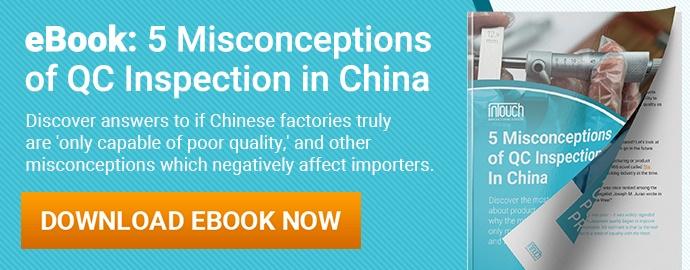![]() Is it normal for your Chinese supplier not to reply to your email? Why did they misunderstand your requirements? And how do you communicate feedback to them that leads to lasting quality improvement?
Is it normal for your Chinese supplier not to reply to your email? Why did they misunderstand your requirements? And how do you communicate feedback to them that leads to lasting quality improvement?
Most importers have struggled to communicate with their overseas supplier at one time or another. Misunderstandings often occur due to persistent misconceptions about manufacturing (related: 5 Misconceptions of QC Inspection in China [eBook]).
From expecting a supplier to interpret vague specifications, to negotiating too low on price, many buyers struggle to work with suppliers overseas. And if you’re among them, you’ve probably wondered what you can do to improve buyer-supplier communication.
Here are nine ways you can start improving communication with your Chinese supplier now:
1. Keep emails simple when communicating with suppliers
Importers sometimes send a barrage of emails to a supplier in a short period of time—all relating to the same issue. These emails sometimes contain technical English, slang or spelling mistakes.
You may feel your Chinese supplier’s English is pretty good. But there’s a strong chance they’re regularly copying your emails directly into an online translator to understand the meaning in their native language.
Sending many different emails, using complicated language or including spelling mistakes in your message can all lead to misunderstandings. And in doing so, you also risk having your supplier miss the key points of your email.
Limit your email correspondence to one simple email chain per topic when possible. Use short words, short sentences and bulleted or numbered lists to help the supplier more easily respond to different points.
A useful tool to help you write in simple English is the free Hemmingway App. Just copy and paste the text of your message into the tool, and it will automatically review and highlight areas where you could improve your writing for easier reading. It also gives you a readability grade to tell you how difficult your writing may be for someone with a specific education or English level.
2. Follow up with a phone call
Getting your contact on the phone is one way to quickly improve communication with suppliers.  It’s often best to contact your supplier by phone if they don’t respond to an email within a reasonable amount of time or become generally unresponsive.
It’s often best to contact your supplier by phone if they don’t respond to an email within a reasonable amount of time or become generally unresponsive.
Reviewing details over the phone can also help you avoid misunderstandings and gauge whether a supplier genuinely understands your message (related: 3 Reasons Your Supplier Might Be Sending You the Wrong Message).
If you doubt your supplier’s understanding, simplify your message like you might if you were explaining to your grandmother. Speaking slowly and in simpler terms will go a long way in ensuring your expectations are clear.
Silence generally means there’s a problem or something is unclear. Chinese suppliers, in particular, sometimes withhold bad news simply by not responding to a customer’s inquiry.
A factory representative in Asia may not proactively reach out and say, “We don’t understand this, can you please explain?”, as it could lead to a loss of face (related: 3 Cultural Barriers You Must Face for Effective China Quality Control). But such a supplier is more likely to ask for clarification if you first call them to confirm.
3. Limit the number of contact people
Having to deal with several different people can complicate buyer-seller communication. Requirements can easily get lost in translation as they’re transferred from one contact to another. Limiting the number of people you talk to can help.
Whenever possible, designate one person from your organization to act as the key contact to liaise with your supplier. That person should ideally be someone sensitive to the local culture with the ability to communicate in simple, easy-to-understand English, or even better, in the local language.
Likewise, your communication can improve by having a single point of contact on the supplier’s end. It’s often best to have a contact that’s actually working in the factory where your goods are being made. Though that’s not always possible, especially if you’re working with a vendor.
This may be difficult if you deal with large factories and multiple projects simultaneously. But remember that the risk for miscommunication rises as more people become involved.
4. Make contact with suppliers through WeChat
WeChat can be an effective mode of communication with Chinese suppliers who are hard to reach by email and phone.
You might not be familiar with the social messaging app WeChat if you’ve never been to China. But it’s hard to overstate the popularity of WeChat in China. In 2018, WeChat reached one billion monthly active users. And in a recent survey, 83 percent of WeChat users said they use WeChat for business communication.
While email remains the preferred communication tool in the West, Chinese professionals largely prefer online chat as their method of choice. Partly due to a lack of desktop PCs at the time email emerged, China never quite fully adopted the Western custom of habitually checking email.
That’s not to say you shouldn’t still rely on email or phone calls for more formal communication like negotiating contracts. But WeChat can be great for informally checking in on your supplier’s progress. You’re more likely to reach suppliers wherever they are—on a train, in a taxi or in the office—with WeChat than with email.
Plus, WeChat has a built-in translation feature. So if language is a major issue, both you and your supplier can converse in your native language and simply translate each other’s responses. You can also make free voice and video calls through the platform to avoid costly international calling fees.
5. Create a QC checklist to set clear quality requirements
Are your requirements spread out in multiple email chains, embedded in a long-winded paragraph or split into several different email attachments? If so, important details are likely lost in the process.
Wouldn’t it be better if you had one central document that you could send to your supplier that includes all your expectations, specifications and tolerances?
In the quality control industry, this kind of document is known as a QC checklist. Along with any approved samples, a QC checklist can serve as a reference of your requirements for both factory staff and QC inspectors.
Sending a QC checklist to your supplier before production even begins is a great way to limit miscommunication. This gives the supplier an opportunity to review your requirements and confirm their ability to meet them, ask questions and offer feedback.
Some importers create their own checklist, while others rely on a third-party inspection company to create one for them. Some even hire a professional to translate their checklist into the supplier’s own language.
Regardless of how you choose to create the document, QC checklists should typically include the following information:
- Product requirements, like dimensions, materials and colors
- Packaging requirements, like labeling, assortment and materials
- Any on-site tests and procedures, including what constitutes a “pass” or “fail” test result
- Quality defect classification, often using a standardized system like AQL
Collecting this information in one place helps you avoid quality issues arising from miscommunication.
6. Share product inspection results with your supplier
Some importers just glance at a product inspection report, check if the result is pass or fail and advise whether to hold or release the shipment accordingly. Then they set the report aside and don’t bother to review it again. They “rinse and repeat” when placing the next order, following the same process but expecting different results.
Whether performed by you or a professional third party on your behalf, outside inspection can pinpoint issues and help your supplier improve. But how can you expect improvement from one inspection or shipment to the next without giving your supplier feedback in between?
Inspectors may find quality issues you didn’t expect could appear. This often happens if you’ve omitted a requirement from your checklist. And if you want to prevent the same issue from reoccurring, you’ll need to communicate the issue and your tolerance for it to your supplier.
Updating your specifications or checklist and sending your supplier a copy of the inspection report can help reinforce your requirements and the types of issues that will prompt you to hold a shipment. Providing specific feedback following inspection also helps your supplier “buy into” inspection as a beneficial process for continuous improvement.
7. Meet with your supplier in person
Not all importers have a budget that allows them to visit their suppliers overseas.  But arranging a visit can be well worth the investment if you’re serious about improving communication and cultivating a long-term relationship with your supplier.
But arranging a visit can be well worth the investment if you’re serious about improving communication and cultivating a long-term relationship with your supplier.
Meeting suppliers in person helps put a face to your name. Large suppliers handle thousands of purchase orders a year. And your requirements can easily get lost in stack of others’. But if you go the extra mile (literally) to visit them, they just might prioritize your orders a little bit more.
It’s also often easier to get reliable, real-time feedback related to important details of the buyer-supplier relationship when discussing in person, including:
- Production deadlines – can the factory meet expected production and shipping milestones, or are delays likely?
- Quality standards – are quality expectations achievable, or are there limitations due to equipment, staff or other constraints?
- Inspection or auditing requirements – will the supplier cooperate with a third-party inspection or auditing firm, or will they likely limit access or otherwise resist the process?
Improve communication and start your relationship on even footing by meeting your supplier in person.
8. Involve your third-party inspection company when liaising with suppliers
Even if you’ve sourced from China for years and routinely visit your suppliers, you might not speak Chinese. And there’s nothing wrong with that—chances are you’ve got much higher priorities!
Working with a third-party inspection company can improve your communication with your supplier in ways you never could without Chinese language abilities.
Professional QC companies employ staff with both local language and English skills for this exact purpose: to enable better communication between you and your supplier.
The communication value of QC company staff often extends beyond helping clarify the inspection process, scope and results to you and your supplier. They can often relay information related to production status or notify you of any discrepancies related to order or SKU quantities.
If you involve your inspection company early enough in the process, they can also support you by clarifying requirements to prevent potential problems later.
9. Trust your supplier (but always verify)
This last point might seem contradictory to some of the above advice. But even the most experienced importers know due diligence is essential when working with a new supplier, no matter how credible that supplier may appear.
You’re never wrong to appropriately confirm the information your supplier communicates to you. In fact, you’d be reckless to blindly trust your supplier if you have any expectations at all for what you’re buying. 
Failure to investigate a supplier’s claims early often leads to a breakdown in communication and in your supplier relationship later.
Trust, but always verify, what your supplier tells you.
Verification activities could include:
- Auditing potential suppliers to verify production capabilities, quality management systems, social compliance or otherwise qualify them
- Reviewing a pre-production sample to verify the supplier’s understanding and capability of meeting product requirements
- Regularly inspecting the goods throughout production to verify order status and product quality
The findings from these activities are most reliable when gathered either by your own staff or a trusted third party. A supplier’s own accounts of their operation are no substitute for an independent review.
Conclusion
Manufacturing products in China is often challenging. And few problems make manufacturing more difficult than hindered buyer-supplier communication.
But as we’ve seen, improving communication with suppliers doesn’t have to be hard. Even taking an extra 30 seconds to review and simplify the emails you send your supplier can do wonders. Or, if you’re feeling more ambitious, a trip to visit your supplier might be just what you need.
Whichever way you choose, the positive impact improving communication can make on your product quality and supplier relationship is almost always is well worth the extra time and effort.
What tips do you have for importers communicating with Chinese suppliers? Share your experiences in the comment section below







